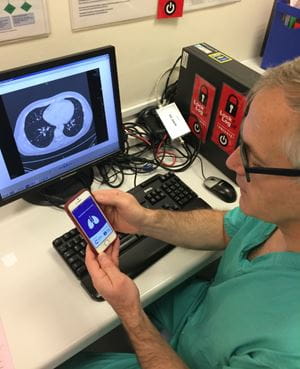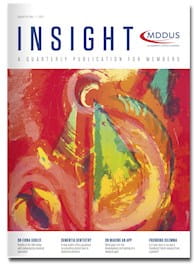 THE list of things that smartphones can do is constantly growing – and their role in assisting healthcare professionals on the ward and in practices is also expanding almost daily.
THE list of things that smartphones can do is constantly growing – and their role in assisting healthcare professionals on the ward and in practices is also expanding almost daily.
Apps in particular have the potential to offer quick and simple answers to some of the key questions doctors face every day. But they need to be reliable and effective.
Recently Cancer Research UK has been involved in developing an app for iPhone and iPads in partnership with the British Thoracic Society (BTS).
Our goal is to make it easy for health professionals to access comprehensive guidelines published in 2015 by the Society on how to manage patients with small tissue growths – called pulmonary nodules – that can appear on lung scans. These nodules can be harmless, but they can also be cancerous and need treatment.
The guidelines have been popular with doctors and the teams they work with, offering information to help diagnose patients with lung cancer as quickly as possible – and without carrying out unnecessary tests on people who don’t need them. But the different hospital staff who use the guidelines are almost always on the move. When we spoke to them it was clear they want the information they need to move with them.
Our app is designed to make that possible.
What are the guidelines for?
When a nodule is found on a scan, doctors must quickly decide if it needs further investigation. They have to balance this with avoiding unnecessary tests and worry for patients who may have harmless (benign) nodules.
The guidelines help doctors decide these next steps – whether to discharge the patient, bring them back for monitoring, or offer further tests that may lead to a lung cancer diagnosis followed by treatment. The guidelines recommend using three different mathematical calculations to assess the risk that the nodule is cancerous and how quickly it’s growing. These have been turned into online calculators which are available on the BTS website.
The guidelines and online calculators have been very popular. Since the start of 2016, the online calculators have been used over 18,700 times, helping doctors make vital decisions around the care of thousands of patients.
But there’s a problem.
How can an app help?
As is often the case in medicine, the lung nodule guidelines contain a huge amount of information. The detail is vital but not something a doctor can quickly refer back to while they’re in the clinic or a multidisciplinary team meeting (MDT) planning how best to care for their patients.
Also, while the calculators are available online, it’s awkward for doctors and their teams to access them when they’re on the wards or in MDTs. Simply using their phone isn’t easy either because they often can’t reliably get Wi-Fi or mobile signal in hospitals.
Our app gets around both these problems. Summaries of the key information are already downloaded onto their phone, purpose built for handling the maths and available whenever they need it.
Doctors helped design the app too
From the start we wanted to ensure that the design and functionality of the app did exactly what the doctors needed it to. First we collected feedback from 18 health professionals. We found that 11 were already using smartphone apps for their work at least several times a month, with three using them several times a day. The feedback also showed that 11 were very likely to use an app version of the guidelines and calculators.
We then worked with our in-house digital experts to develop a prototype app that we took to hospitals in Leeds and London to get more feedback and understand how doctors might use it. We found that the doctors and their teams were always on the move around the hospital. This means they often won’t have easy access to a computer when they need to make decisions about their patients.
We also found that there are a lot of different people who need to use the guidelines. And they all have slightly different needs. For example, the nurses supporting patients as they are having the scans and tests might use the app in a different way from the doctors interpreting what the scan results mean. So the easier we could make it for different people to access what was relevant to them, without having to spend lots of time referring back to the full guidelines, the better.
What difference will it make?
We hope the app gives health professionals all the information they need, where and when they need it. After extensive tests, a group of health professionals from across the country have been using the app in their hospitals over the last month. They’ve kindly given us their feedback, and early signs are positive.
"The app makes it much easier to plan nodule follow-up in clinics and MDTs as you don’t have to wait for the website to load and it’s much more phone-screen-friendly,” said one user.
“Having the calculator immediately to hand saves me time spent finding a PC and getting through to the risk calculator online or trying to use mobile data to get there,” said another.
We hope that many more doctors will now get similar benefits from the app and that it can help make sure the thousands of patients found to have pulmonary nodules each year get the best possible care.
What happens next?
Since launching in December 2016 the app has already been downloaded over 1,000 times. We’re going to collect more feedback on the app to understand what features are most valuable to people and any areas we could improve it. Assuming the app continues to be successful, we’ll be working with the British Thoracic Society to develop versions that will work across other mobile operating systems, such as Android and Windows to give more people access to it.
We hope this app can help us to start to realise the potential for smartphones in supporting doctors and improving patient care. We’ll be keen to learn any lessons that can help us develop apps to support other areas of cancer patient care. We also hope this app will be a useful example for us and others of how apps can help improve patient care in general with quick and simple solutions.
Matt Wickenden is a cancer intelligence manager at Cancer Research UK
▪ A version of this article originally appeared on the Cancer Research UK Science blog (access at www.cancerresearchuk.org)
This page was correct at the time of publication. Any guidance is intended as general guidance for members only. If you are a member and need specific advice relating to your own circumstances, please contact one of our advisers.
Read more from this issue of Insight

Save this article
Save this article to a list of favourite articles which members can access in their account.
Save to library

